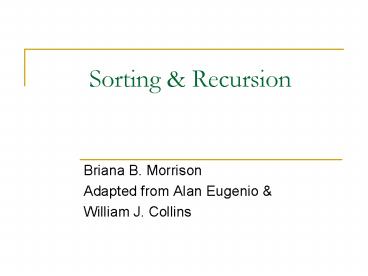Sorting - PowerPoint PPT Presentation
1 / 113
Title:
Sorting
Description:
Loops through input and 'selects' smallest/largest value and swaps with current ... http://cg.scs.carleton.ca/~morin/misc/sortalg/ Sorting. 112. Summary Slide 1 ... – PowerPoint PPT presentation
Number of Views:26
Avg rating:3.0/5.0
Title: Sorting
1
Sorting Recursion
- Briana B. Morrison
- Adapted from Alan Eugenio
- William J. Collins
2
Topics
- Review
- Insertion Sort
- Selection Sort
- Bubble Sort
- This term
- Tree Sort
- Heap Sort
- Radix Sort
- New
- Merge Sort
- Quick Sort
3
(No Transcript)
4
(No Transcript)
5
(No Transcript)
6
(No Transcript)
7
(No Transcript)
8
(No Transcript)
9
(No Transcript)
10
(No Transcript)
11
(No Transcript)
12
(No Transcript)
13
(No Transcript)
14
Selection Sort
- Loops through input and selects
smallest/largest value and swaps with current
location - Worst case O(n2)
- Average case O(n2)
15
(No Transcript)
16
(No Transcript)
17
(No Transcript)
18
(No Transcript)
19
(No Transcript)
20
(No Transcript)
21
Bubble Sort
- Loops through input doing adjacent comparisons
- Biggest/smallest element bubble to top/bottom
- Worst case O(n2)
- Average case O(n2)
22
(No Transcript)
23
(No Transcript)
24
(No Transcript)
25
(No Transcript)
26
(No Transcript)
27
(No Transcript)
28
(No Transcript)
29
(No Transcript)
30
(No Transcript)
31
(No Transcript)
32
(No Transcript)
33
(No Transcript)
34
(No Transcript)
35
(No Transcript)
36
(No Transcript)
37
(No Transcript)
38
(No Transcript)
39
(No Transcript)
40
(No Transcript)
41
(No Transcript)
42
(No Transcript)
43
(No Transcript)
44
(No Transcript)
45
(No Transcript)
46
(No Transcript)
47
(No Transcript)
48
FOR TREE SORT, EACH INSERTION
TAKES LOGARITHMIC TIME AT MOST, SO FOR
n INSERTIONS worstTime(n) IS O(n log n).
therefore averageTime(n) IS O(n log
n)
49
(No Transcript)
50
(No Transcript)
51
(No Transcript)
52
(No Transcript)
53
(No Transcript)
54
Heapify done.
55
Sort done.
56
(No Transcript)
57
Radix Sort
- Recall that Radix Sort uses a vector of queues to
distribute and then collect from least
significant position to most significant
position. - Performance is O(nd) where d is the length of
the key ( of digits) - Remember that Radix Sort IS NOT a comparison
based sort.
58
Divide Conquer Sorts
- Divide and conquer is a problem solving technique
that uses recursion - Divide problem into smaller problems that lead to
recursive step or stopping condition - Combine solutions to solve original
- Usually have 2 or more recursive calls that
involve disjoint collections
59
Mergesort vs. Quicksort
- Mergesort
- Divides collection to smallest solvable problem
- Combines solutions (this is where the work is)
- Quicksort
- Divides collection by a pivot (this is where the
work is) - Combines solutions
60
(No Transcript)
61
(No Transcript)
62
The Merge Algorithm Example
- The merge algorithm takes a sequence of elements
in a vector v having index range first, last).
The sequence consists of two ordered sublists
separated by an intermediate index, called mid.
63
The Merge Algorithm (Cont)
64
The Merge Algorithm (Cont)
65
The Merge Algorithm (Cont)
66
(No Transcript)
67
(No Transcript)
68
(No Transcript)
69
(No Transcript)
70
(No Transcript)
71
(No Transcript)
72
(No Transcript)
73
(No Transcript)
74
(No Transcript)
75
(No Transcript)
76
Partitioning Merging in mergeSort()
77
Function calls in mergeSort()
78
(No Transcript)
79
(No Transcript)
80
(No Transcript)
81
(No Transcript)
82
(No Transcript)
83
(No Transcript)
84
(No Transcript)
85
(No Transcript)
86
Quicksort Example
- The quicksort algorithm uses a series of
recursive calls to partition a list into smaller
and smaller sublists about a value called the
pivot. - Example Let v be a vector containing 10 integer
values - v 800, 150, 300, 650, 550, 500, 400, 350,
450, 900 - Easy ways to choose the pivot
- First value
- Middle value
- Last value
87
Quicksort Example
- Choose pivot as middle value, swap with first
value. - Example Let v be a vector containing 10 integer
values - v 800, 150, 300, 650, 550, 500, 400, 350,
450, 900
88
Quicksort Example (Cont)
89
Quicksort Example (Cont)
90
Quicksort Example (Cont)
91
- Now swap the pivot with the value pointed to by
scanDown - Then generate the recursive calls
92
Quicksort Example (Cont)
93
Quicksort Example (Cont)
94
Quicksort Example (Cont)
95
Quicksort Example (Cont)
96
(No Transcript)
97
(No Transcript)
98
(No Transcript)
99
(No Transcript)
100
(No Transcript)
101
(No Transcript)
102
(No Transcript)
103
(No Transcript)
104
(No Transcript)
105
(No Transcript)
106
Lets See Them Run
- // load the vectors with the same sequence of
100000 - // random numbers in the range 0 to 999999
- for(i0i lt VECTORSIZEi)
- rndNum rnd.random(1000000)
- v1.push_back(rndNum)
- v2.push_back(rndNum)
- v3.push_back(rndNum)
- v4.push_back(rndNum)
- timeSort(v1,HEAPSORT,"Heap sort")
- timeSort(v2,MERGESORT,"Merge sort")
- timeSort(v3,QUICKSORT,"Quick sort")
- timeSort(v4,INSERTIONSORT,"Insertion sort")
107
(No Transcript)
108
(No Transcript)
109
(No Transcript)
110
(No Transcript)
111
Sorting Animations
- http//www.cs.hope.edu/alganim/animator/Animator.
html - www2.dcc.ufmg.br/dorgival/applets/SortingPoints/S
ortingPoints.html - http//cg.scs.carleton.ca/morin/misc/sortalg/
112
Summary Slide 1
- Divide-and-Conquer Algorithms - splits a
problem into subproblems and works on each
part separately - Two type of
divide-and-conquer strategy 1) mergesort
algorithm - Split the range of
elements to be sorted in half, sort each
half, and then merge the sorted sublists
together. - running time O(n
log2n), requires the use of an auxiliary
vector to perform the merge steps.
113
Summary Slide 2
2) quicksort algorithm - uses a
partitioning strategy that finds the final
location of a pivot element within an
interval first,last). - The
pivot splits the interval into two parts, first,
pivotIndex), pivotIndex, last). All elements
in the lower interval have values ? pivot
and all elements in the upper interval have
values ? pivot. - running time
O(n log2n) - worst case of O(n2),
highly unlikely to occur

